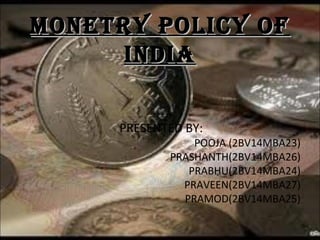This document discusses India's monetary policy as administered by the Reserve Bank of India (RBI). It outlines the RBI's goals of maintaining price stability and economic growth through controlling interest rates and money supply. The RBI employs various measures of money stock (M1-M4) and tools of monetary policy, including statutory liquidity ratio, cash reserve ratio, and repo and reverse repo rates, to achieve its objectives of financial stability, inflation control, and price stability.













